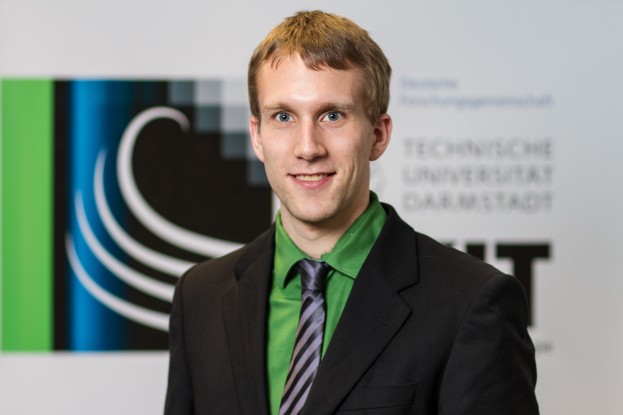Dr.-Ing. Sebastian Bürkle
Working area(s)
Reactive Flows and Diagnostics, AG turbo, SFB/Transregio 150, SFB/Transregio 129 - Oxyflame
Contact
Due to rising prices for primary energy sources as well as both, increasing shortage and demand of resources, an efficient use of existing energy sources will continue to be an important topic. The increasing contribution of alternative energy sources to the power supply requires further development of gas turbines, specifically in terms of increasing efficiency.
One of the most important factors for an increase of the efficiency of modern gas turbines is the turbine entry temperature (TET), which is the gas temperature at the first stator of the turbine downstream of the combustion chamber. Depending on the technology level, the TET significantly exceeds 1000 K, but is still below the stoichiometric temperature of roughly 2000 K. An accurate determination of the temperature is essential for the design of the turbine components and their lifetime. The hottest parts are usually cooled with air or steam flows, and even small variations of the temperature or its distribution have a negative impact on either the lifetime of the component or the efficiency of the process. Therefore, designing the turbine with respect to the expected maximal temperatures is of great importance, as well as a precise determination of these temperatures by appropriate experimental methods in combination with process-models.
Due to the very high turbine entry temperatures, however, the most common temperature measurement methods are no longer applicable. Thermocouples are currently still state of the art, but the materials used during TET diagnostics are already operated at their thermal limit and the fatigue is accordingly high.
Method
Laser-optical methods, based on Tunable Diode Laser Absorption Spectroscopy (TDLAS), provide a promising approach to minimally-invasive measurement of the TET. Particularly in the near infrared spectral range (NIR), the TDLAS provides a hardly achievable combination of selectivity and sensitivity for technical applications, combined with moderate costs and high robustness.
Within the TURBO AG 2020 joint research project we are developing a spectrometer for in-situ measurement of the TET, based upon this technique. The spectrometer is designed to meet the requirements of a high-pressure combustion chamber, as well as to investigate the possible use of TDLAS for the optical determination of the TET in large industrial gas turbines. As TDLAS is a robust method for calibration-free and contactless measurement of absolute species concentration and temperature in combustion processes, it has the potential to allow the determination of the integral temperature, even in such difficult access and harsh environments, and serves as a basis for the newly developed spectrometer.
Based on tunable diode lasers with a narrow bandwidth (DFB, VCSEL), a high resolution detection of rotational-vibrational spectra and an accurate and reliable extraction of the TET in the complex environment of a gas turbine combustor are possible. Using two-line thermometry1 2, the gas temperature along the laser line can be determined in a purely optical way from the simultaneous measurement and comparison of several, suitably chosen absorption lines of a single species. For this purpose, rotational-vibrational transitions of H2O in the near infrared are used. The great number of interfering species within gas turbine combustors, as well as the high temperatures and pressures require innovative spectrometer concepts in order to ensure a reliable measurement.
Publications
Bürkle, S., Greifenstein, M., Wagner, S., Dreizler, A., Ebert, V.: Optical Sensing of Turbine Inlet Temperature in a Pressurized Gas Turbine Combustor, in: Imag. and Appl. Opt. 2016, OSA technical Digest, paper LT4F.4., doi: 10.1364/LACSEA.2016.LT4F.4 (2016)
Doost, A. S., Ries, F., Becker, L. G., Bürkle, S., Wagner, S., Ebert, V., Dreizler, A., di Mare, F., Sadiki, A. and Janicka, J.Residence time calculations for complex swirling flow in a combustion chamber using large-eddy simulations, Chemical Engineering Science, 156: 97-114, 2016.
M.A. Agizza, S. Bürkle, L. Becker, M. Greifenstein, G. Bagheri, S. Doost, T. Faravelli, J. Janicka, S. Wagner, A. Dreizler: Reactor network modelling of a close to reality combustor using residence time measurements. European Combustion Meeting, Dubrovnik, Croatia, April 2017
Bürkle, S., Becker, L.G., Agizza, M.A., Dreizler, A., Ebert, V., Wagner, S.: In-situ measurement of residence time distributions in a turbulent oxy-fuel gas-flame combustor. Exp Fluids (2017) 58: 77. doi:10.1007/s00348-017-2366-2
Bürkle, S., Möller, G., Hees, J., Zabrodiec, D., Rauen, D., Ebert, V. Kneer, R., Dreizler, A., Wagner, S.: Laserbasierte Messung der Temperatur und Spezieskonzentrationen der Feuerung von torifizierter Biomasse in einer 100 kWth Staubfeuerungsversuchsanlage, 28. Deutscher Flammentag - Verbrennung und Feuerung, Darmstadt, Deutschland, 2017.


